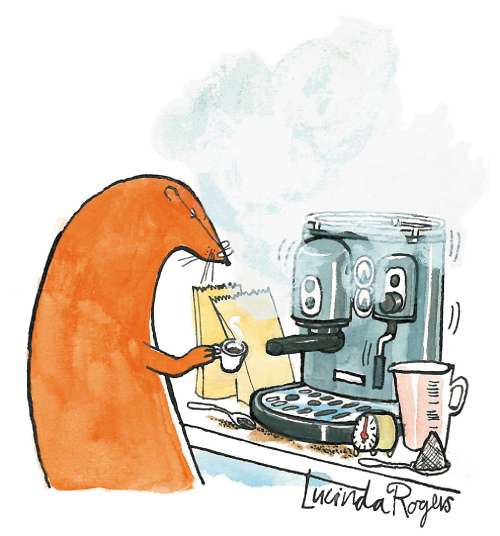The Weasel: The daily grind

Despite having an enjoyable time with Henry Hitchings's etymological ramble The Secret Life of Words (Murray, £16.99), I found myself getting into a froth on page 320 where he explores the topic of cappuccino.
"To anyone under 20, the years 'BC' (Before Cappuccino) may sound like the time of myth," writes Mr Hitchings, who is no old-timer himself (born 1974). "For many younger consumers, the drink is inextricably linked with Starbucks." Noting that the first Starbucks outside North America opened in Tokyo in 1996, he concludes: "The drink and its purveyors haven't been around all that long."
"Grrrruph!" I ejaculated, much in the manner of an ancient espresso machine doing its stuff with the Arabica. I am no great fan of Starbucks. Their coffees are too big, too hot and too mystifying. (Whatever a "skinny caffè mocha" might be, I don't like the sound of it.) But this was not the cause of my eruption. It was a middle-aged response to Mr Hitchings's suggestion that coffee with bubbles is a recent innovation in Britain. The term for this item, which derives from the coffee-coloured habit of the Franciscan order of Friars Minor Capuchins, may only have become commonplace in the past decade or so, but the drink was around avant la lettre or, more accurately, prima della lettera.
Frothy coffee, as it was known, was all the rage in the late Fifties. It may not have had much espresso at its foundation, but there was no shortage of froth. A cupful resembled a miniature bubble bath (another leitmotif of the era that shrouded the charms of Monroe, Mansfield and Dors). It was frothy coffee that fuelled the wild beat rhythms of Tommy, Cliff, Hank, Jet et al in the 2i's coffee bar on Old Compton Street. In the Tony Hancock film The Rebel (1960), the lugubrious coffee bar owner Mario Fabrizi looks pop-eyed when the Lad Himself rejects this icon of youth culture. "You want a coffee with no froth!" declares the disbelieving Mario, his magnificent 'tash spiky with agitation.
Mrs W took a Hancockian line when I offered her a cappuccino the other day, though there was some justification since it was around 2pm. As Burton Anderson remarks in his book Pleasures of the Italian Table: "Italians, who drink it in the morning, may be amused or appalled to see foreign visitors order it after lunch or dinner." Henry Hitchings is even more specific: "It is consumed with a spoon, standing up, before 11am." My wife's reluctance to commit a caffeinated solecism may have accorded with local habits from Arezzo to Zambrone, but it prevented me from practising my barista skills with our new espresso machine. We settled for an espresso, which, incidentally, does not rate a mention by Mr Hitchings. This is possibly because it has not really entered the English language. Many persist in referring to the drink as an "expresso", which is not only a mishearing but a mistranslation. Espresso does not mean "speedy" but "especially". It is made especially for you, though the real tailor-made versions are the ristretto (restricted to a few super-strong drops), caffè macchiato (spotted with milk) and the admirable caffè corretto (corrected with grappa, whisky or whatever you fancy).
This is the second espresso machine to enter Weasel Villas. The first one was OK for espresso, but proved too slow heating the milk for cappuccino. Due to its sluggish seething, I doubt if I used it for more than four cappuccini. Moreover, it didn't have a temperature gauge. Not a major defect, but we chaps like a gauge. (Similar to barbecues, espresso machines are generally a male preserve.) Without wanting to sound like Mr Machismo, I might point out that my gleaming new gizmo has two temperature gauges. This is because it has two boilers, one for espresso, one for frothing milk. These gleaming, phallic protuberances would not look out of place on Captain Nemo's leviathan submarine Nautilus. Come to think of it, Burton Anderson's description of espresso-making has more than a hint of Jules Verne: "The packed powder must be just porous enough so that water at 194F under pressure of about nine atmospheres will propel an even discharge through the spouts." Coo. I feel a little faint when I consider the power at my command, though the raison d'être of the machine is to make a cup of caffè rather than head 20,000 leagues under the sea.
It may come as a surprise that this steamy behemoth bears the name KitchenAid, a company based in Greenville, Ohio. I can imagine citizens of the Italian peninsula bristling somewhat when they encounter a section in the multi-lingual instruction manual that explains "Cos'è un Espresso?" ("What is an Espresso?"), but there is no need for them to bust a boiler. European purchasers are assured that it is: "Prodotto in Italia." Though the brew head of chrome-plated brass, frothing arm ("pivots horizontally and vertically") and 15-bar self-priming pump are undeniably impressive, there may remain one small question in sceptical minds: can it produce a decent cup of coffee? Well, yes, it can. The espresso is excellent, topped with a thick crema of golden foam. Thanks to the "frothing boiler", the cappuccino is speedy and better than you get in many High Street coffee bars (no names, no pack drill). I've made maybe a dozen already, though, of course, never after 11am. It is slightly surprising that a device aiming for coffee perfection does not include a clock to indicate the cappuccino cut-off time.

Join our commenting forum
Join thought-provoking conversations, follow other Independent readers and see their replies